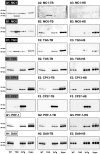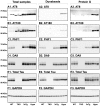Specificity of anti-tau antibodies when analyzing mice models of Alzheimer's disease: problems and solutions
- PMID: 24788298
- PMCID: PMC4008431
- DOI: 10.1371/journal.pone.0094251
Specificity of anti-tau antibodies when analyzing mice models of Alzheimer's disease: problems and solutions
Abstract
Aggregates of hyperphosphorylated tau protein are found in a group of diseases called tauopathies, which includes Alzheimer's disease. The causes and consequences of tau hyperphosphorylation are routinely investigated in laboratory animals. Mice are the models of choice as they are easily amenable to transgenic technology; consequently, their tau phosphorylation levels are frequently monitored by Western blotting using a panel of monoclonal/polyclonal anti-tau antibodies. Given that mouse secondary antibodies can recognize endogenous mouse immunoglobulins (Igs) and the possible lack of specificity with some polyclonal antibodies, non-specific signals are commonly observed. Here, we characterized the profiles of commonly used anti-tau antibodies in four different mouse models: non-transgenic mice, tau knock-out (TKO) mice, 3xTg-AD mice, and hypothermic mice, the latter a positive control for tau hyperphosphorylation. We identified 3 tau monoclonal antibody categories: type 1, characterized by high non-specificity (AT8, AT180, MC1, MC6, TG-3), type 2, demonstrating low non-specificity (AT270, CP13, CP27, Tau12, TG5), and type 3, with no non-specific signal (DA9, PHF-1, Tau1, Tau46). For polyclonal anti-tau antibodies, some displayed non-specificity (pS262, pS409) while others did not (pS199, pT205, pS396, pS404, pS422, A0024). With monoclonal antibodies, most of the interfering signal was due to endogenous Igs and could be eliminated by different techniques: i) using secondary antibodies designed to bind only non-denatured Igs, ii) preparation of a heat-stable fraction, iii) clearing Igs from the homogenates, and iv) using secondary antibodies that only bind the light chain of Igs. All of these techniques removed the non-specific signal; however, the first and the last methods were easier and more reliable. Overall, our study demonstrates a high risk of artefactual signal when performing Western blotting with routinely used anti-tau antibodies, and proposes several solutions to avoid non-specific results. We strongly recommend the use of negative (i.e., TKO) and positive (i.e., hypothermic) controls in all experiments.
Conflict of interest statement
Figures







References
-
- Querfurth HW, LaFerla FM (2010) Alzheimer's disease. The New England journal of medicine 362: 329–344. - PubMed
-
- Selkoe DJ (2001) Alzheimer's disease: genes, proteins, and therapy. Physiological reviews 81: 741–766. - PubMed
-
- Buée L, Bussière T, Buée-Scherrer V, Delacourte A, Hof PR (2000) Tau protein isoforms, phosphorylation and role in neurodegenerative disorders. Brain research Brain research reviews 33: 95–130. - PubMed
Publication types
MeSH terms
Substances
Grants and funding
LinkOut - more resources
Full Text Sources
Other Literature Sources
Medical
Miscellaneous

